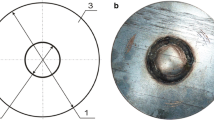Abstract
The magnetic memory of metal is an after-effect, which occurs in the form of metal residual magnetization in components and welded joints formed in the course of their fabrication and cooling in the weak magnetic field of the earth. It also occurs in the form of irreversible change of components’ magnetization in zones of stress concentration and damage under working loads. This article describes the experience with carrying out comprehensive testing of base metal and welded joints of welded steel structures (piping, pressure vessels, etc.) and steam turbine parts by using the method of metal magnetic memory and other conventional nondestructive testing methods, and microstructure analysis. It is shown that the stress concentration zones are the locations of defects and/or material properties degradation.




















Similar content being viewed by others
Notes
In Russia for testing by MMM method special instruments—testers of stress concentration (TSC) (manufacturer Energodiagnostika Co. Ltd.) were certified by Federal Agency on Technical Regulating and Metrology (the National Standards Body) of the Russian Federation.
References
Major accidents of gas pipelines in Russia in the period 2007–2012 // The RIANOVOSTI - 28 of December , 2012 http://ria.ru/spravka/20121228/916527963.html
Lagadec P. Major Technological Risk. An Assessment of Industrial Disasters. — 1st ed. — Pergamon Press, 1982
Vlasov V.T. and Dubov A.A.: Physical bases of the metal magnetic memory method. Moscow: ZAO “TISSO”, 2004. 424 p
Dubov A., Kolokolnikov S. Quality assurance of welded joints in power engineering by the metal magnetic memory method. Proceeding of the IIW International Conference “Safety and Reliability of Welded Components in Energy and Processing Industry, 10–11 July 2008, Graz, Austria. p.709-714
Dubov A, Kolokolnikov S (2010) Comprehensive diagnostics of parent metal and welded joints of steam pipeline bends. Welding in the World 54(9/10):R241–R248
Dubov А, Kolokolnikov S (2012) Assessment of the material state of oil and gas pipelines state based on the metal magnetic memory method. Welding in the World 56(03/04):11–19
IIW/Com-V-1346-06 r2 Quality assessment of welded joints by the metal magnetic memory method compared to conventional NDT methods and means for materials’ properties assessment А. Dubov, S. Kolokolnikov
Roskosz M (2011) Metal magnetic memory testing of welded joints of ferritic and austenitic steels. NDT&E International 44:305–310. doi:10.1016/j.ndteint.2011.01.008
ISO 24497–1:2007, Nondestructive testing—metal magnetic memory—Part 1: Vocabulary, 2007
ISO 24497–2:2007, Nondestructive testing—metal magnetic memory—Part 2: General requirements, 2007
ISO 24497–3:2007, Nondestructive testing—metal magnetic memory—Part 3: Inspection of welded joints, 2007
J. Kaleta, J. Žebracki Application of the Villari effect in a fatigue examination of nickel/Fatigue & Fracture of Engineering Materials & Structures. Volume 19, Issue 12, Pages 1435–1443. 1996
Trémolet de Lacheisserie E (1993) Magnetostriction theory and applications of magnetoelasticity, CRC Press, Inc., Boca Raton, FL
Document of IIW/Com-V: V-1441-09 Dubov A.A., Kolokolnikov S.M., Development of the technique for gas pipeline girth welded joints inspection based on the metal magnetic memory method
Document of IIW/Com –V: V-1347-06r4 Dubov A.A., Dubov Al. A., Kolokolnikov S.M, Method of metal magnetic memory (MMM) and inspection instruments. Training handbook
Author information
Authors and Affiliations
Corresponding author
Additional information
Doc. IIW-2418, recommended for publication by Commission V “NDT and Quality Assurance of Welded Products”.
Rights and permissions
About this article
Cite this article
Dubov, A., Dubov, A. & Kolokolnikov, S. Application of the metal magnetic memory method for detection of defects at the initial stage of their development for prevention of failures of power engineering welded steel structures and steam turbine parts. Weld World 58, 225–236 (2014). https://doi.org/10.1007/s40194-013-0102-y
Received:
Accepted:
Published:
Issue Date:
DOI: https://doi.org/10.1007/s40194-013-0102-y




